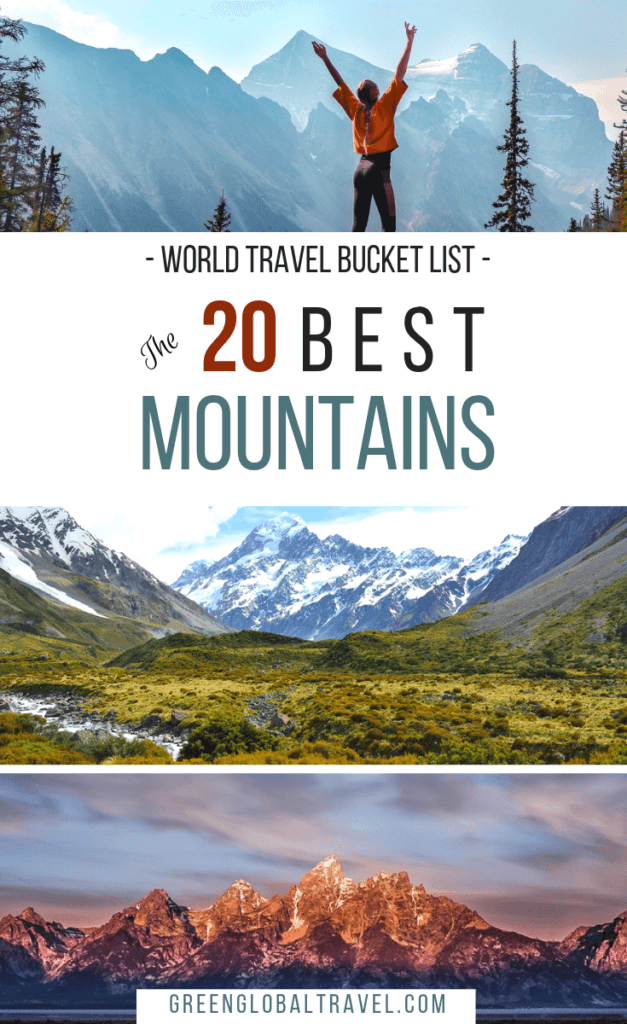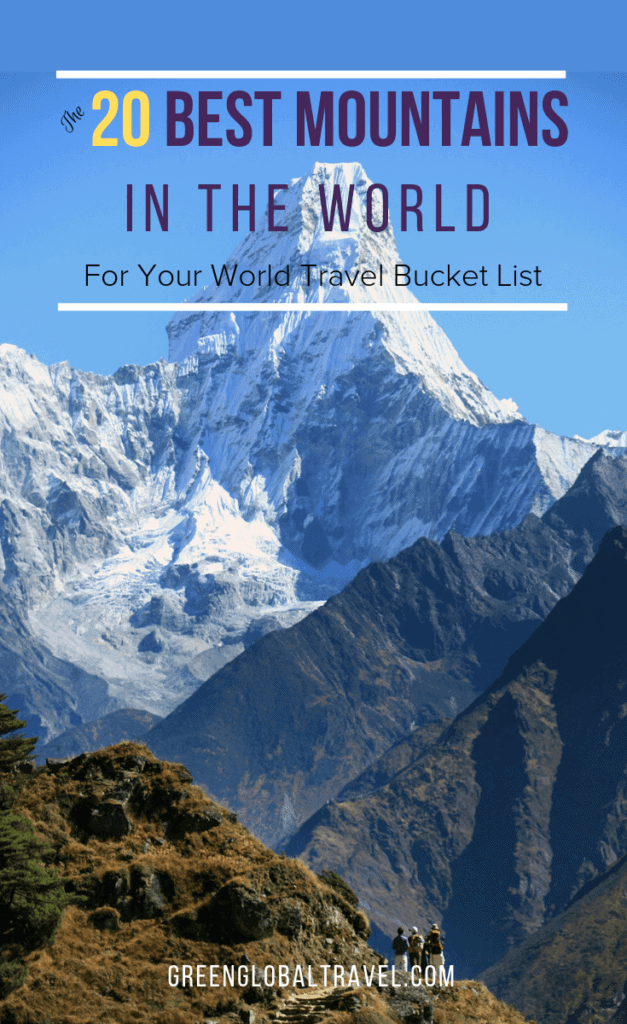By what standards should we measure “the best mountains in the world”?
Should it the most popular mountains? The biggest and tallest mountains? The most challenging for climbers? Or perhaps the most historically significant to the region in which they’re found?
For us, the best mountains are those that capture the imagination of locals and visitors alike. The ones that have played a role in local folklore for centuries, and which continue to draw travelers from around the world today.
It’s not just size that matters here. It’s the dynamic landscapes. It’s the flora and fauna found in the area. Chances are good that, if a mountain has been protected by National Park or UNESCO World Heritage Site status, it’s probably worthy of your bucket list consideration.
We’ve been fortunate to see some extraordinary mountains in our travels. From the Blue Ridge Mountains in the southeast to the remote landscapes of Alaska and Hawaii, the United States has been blessed with more then her fair share and picturesque peaks.
But every continent boasts its own impressive pinnacles worthy of appreciation (including the Seven Summits and the Seven Volcanic Summits). From the Appalachians, Andes, and Rocky Mountains to the Alps, Pyrenees, and mighty Himalayas, the planet offers countless ranges to explore.
So here’s a look at our totally subjective picks for the 20 Best Mountains in the World, some of which we’ve already visited, and many of which we hope to visit in the future…
READ MORE: The 20 Tallest Mountains in the World By Continent
LIST OF THE BEST MOUNTAINS IN THE WORLD
- Mount Kilimanjaro (Tanzania)
- Table Mountain (South Africa)
- Ama Dablam (Nepal)
- Bogda Peak (China)
- Mount Everest (Nepal/Tibet)
- Mount Fuji (Japan)
- Zhangjiajie (China)
- Jotunheimen Mountains (Norway)
- Kirkjufell (Iceland)
- The Pyrenees (France/Spain)
- Swiss Alps (Switzerland)
- Aoraki/Mt. Cook (New Zealand)
- Uluru (Australia)
- Cerro Torre (Argentina/Chile)
- Huayna Picchu (Peru)
- Torres del Paine (Chile)
- Vinicunca (Peru)
- Grand Teton (United States)
- Mauna Kea (United States)
- Mount Logan (Canada)
BEST MOUNTAINS IN THE WORLD MAP
BEST MOUNTAINS IN AFRICA
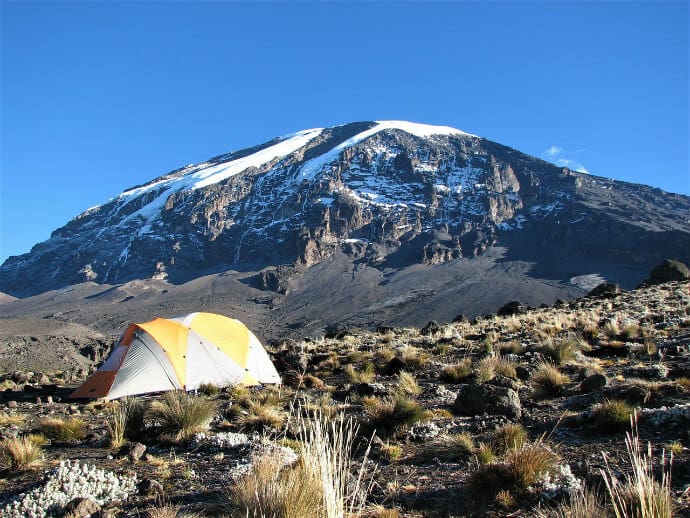
Mount Kilimanjaro (Tanzania)
Mount Kilimanjaro is world renowned as the highest mountain in Africa, one of the famed Seven Summits.
Towering at 19,340 feet, it is topped with multiple glaciers and a small (and gradually diminishing) ice field, despite being located just 190 miles south of the equator. The snowy summit is known as Kipoo in Swahili, the local language.
First climbed in 1889, the mountain is now an extremely popular hiking destination. Its summit is relatively achievable for almost anyone who is fit in terms of both health and bank balances. Just make sure that you pay attention to your guide’s admonitions to go “pole pole” (slowly).
Along the way to the photogenic summit, hardy hikers see virtually every climate, from tropical to arctic. Visitors who prefer to stay closer to sea level can also get a stunning view up from the neighboring town of Moshi.
There’s also a variety of wildlife found in Kilimanjaro National Park, predominantly below the tree line. Blue monkeys and western black and white colobuses can often be spotted (or heard) in the forest, plus leopards, elephants and cape buffaloes can be found.
READ MORE: Top 10 Tanzania National Parks (The Ultimate Tanzania Safari)
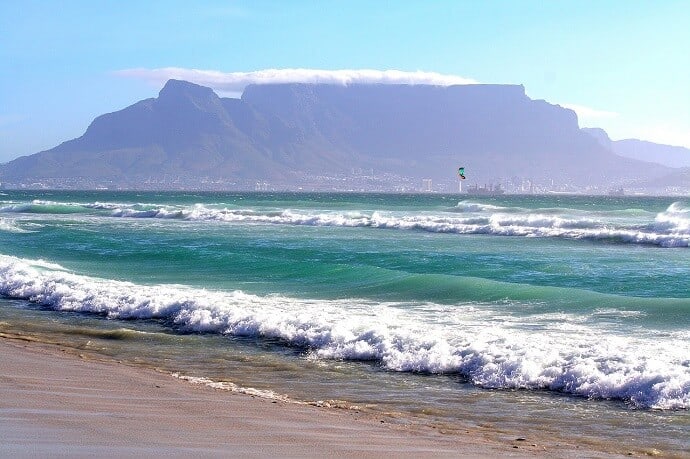
Table Mountain (South Africa)
One of the most unique natural structures on the planet, this aptly named South Africa attraction looks like a piece of furniture for the gods.
Table Mountain is one of the shortest mountains on this list at a measly 3,558 feet. But what it lacks in height, it more than makes up for in prominence. Overlooking Cape Town, the mountain is a picturesque landmark that is familiar to many South African travelers.
Essentially, this is a very tall and distinct plateau that’s roughly two miles across, with each end dropping off into vertigo-inducing cliffs. On the east side, Devil’s Peak neighbors it. On the west side, Lion’s Head bookends the formation.
What makes Table Mountain a fun feature is that, unlike the other mountains on this list, this one can be climbed via cable car (built in October 1929). Hiking up the mountain is also an option.
Along the way, there are thousands of endemic species to look out for. From the top, the gorgeous city of Cape Town spreads out before you to its famous coastal border.
READ MORE: My Life Changing Experience in South Africa
BEST MOUNTAINS IN ASIA
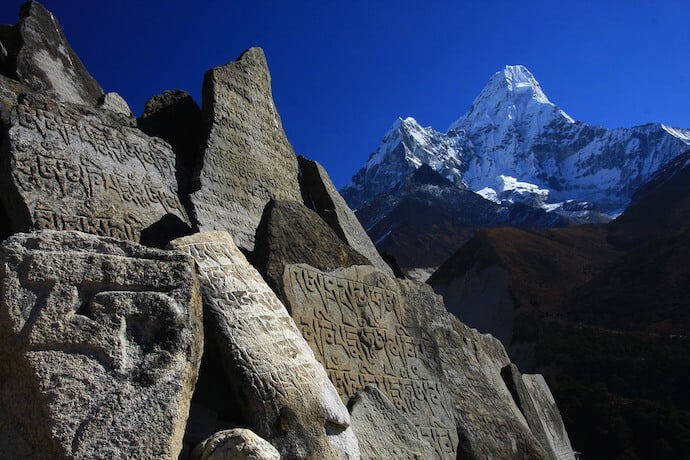
Ama Dablam (Nepal)
When you talk about the biggest mountains in the world, the vast majority are found in the Himalayas. This 1,500 mile range stretch from Pakistan and India east to China, Bhutan, and Nepal. It’s home to more than 50 mountains that stand over 23,600 feet.
At a mere 22,349 feet, Nepal’s Ama Dablam is nowhere near the tallest mountain in the range. But it is the third most popular peak in the Himalayas in terms of permitted climbing expeditions.
The first summit of the mountain was back in 1961 by a team of US, UK, and New Zealand-based climbers. They had previously acclimatized over winter at the base camp established on an expedition with legendary mountaineer Sir Edmund Hillary.
The mountain’s name means “Mother’s necklace.” Locals say that the long ridges on each side of the summit look like the arms of a mama protecting her child. The hanging glacier resembles the traditional double-pendant necklace often worn by Sherpa women, which contain pictures of the gods.
Peak climbing season here is from April to May (before that annual monsoon) and September to October. All climbers are required to get a climbing permit and a liaison officer.
READ MORE: Hiking the Annapurna Circuit Trek
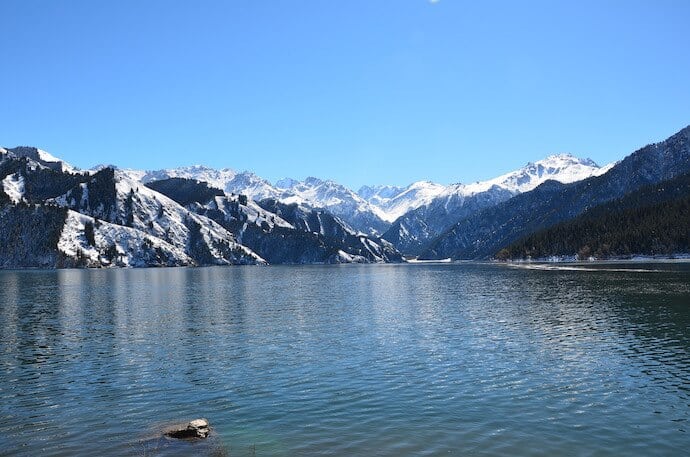
Bogda Peak (China)
Located in China, the Bogda Peak (which is sometimes referred to as Bogda Mountain) stands at a whopping 17,800-plus feet high.
The mountain is noted as being particularly striking because its sides are so incredibly steep, sloping at angles between 70 and 80 degrees. Even so, the mountain has been climbed successfully on numerous occasions.
In reality, the Bogda Peak is the highest of a two-mile, permanently snow capped ridge that juts forth from Central Asia’s UNESCO-protected Tian Shan mountain range.
Making it even more remarkable, the northern perimeter of the mountain drops into the Turpan Depression, which is an earthly hollow located some 500 feet below sea level.
Amazingly, there are other mountains within the Tian Shan range that reach even greater heights. Pik Pobedy summits at 24,589 feet, while Khan Tengri is a couple of feet shy of 23,000.
Even so, because Bogda Peak is nearer to civilization and offers a unique challenge in steepness, it gets more attention.
READ MORE: Top 10 Things To Do in China (For Nature Lovers)
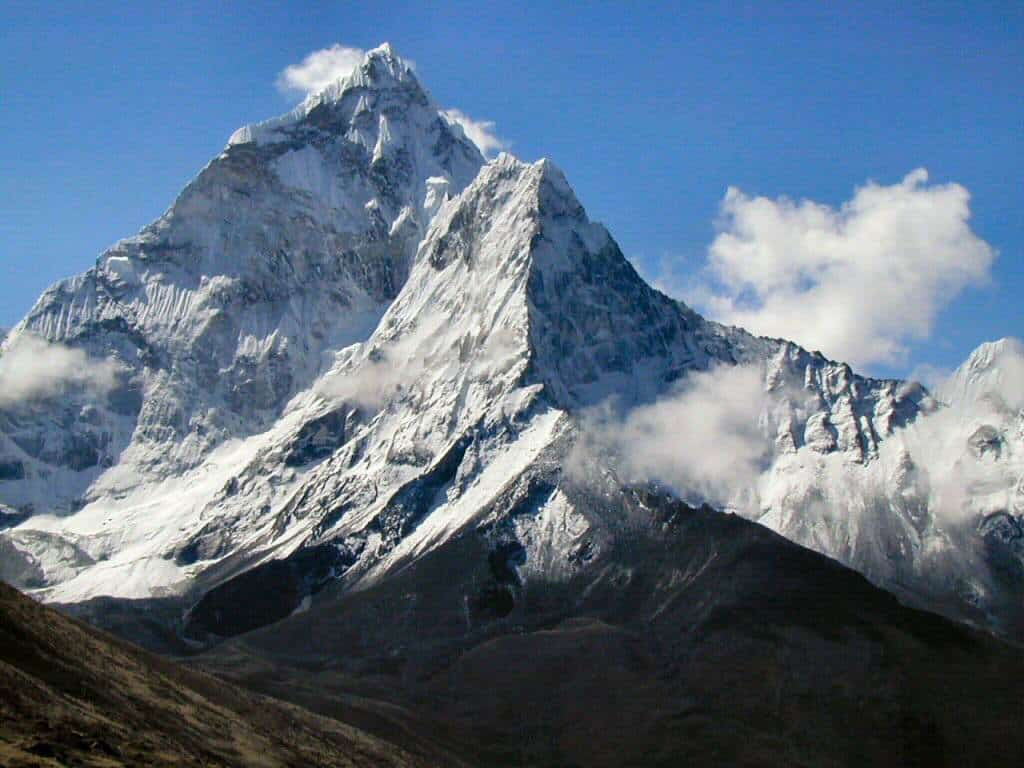
Mount Everest (Nepal/Tibet)
Yes, we’re aware of the fact that Ama Dablam is a part of the same Himalayan mountain range as the almighty Mount Everest. And while we’d normally try to avoid featuring two mountains from the same range, no list of superlative mountains can ignore Everest and still be considered legit.
At 29,029 feet above sea level, Everest’s size is hard to quantify. However, with its challenging climbing routes and fabled (some might say tragic) history, its attraction surely is not. Many people consider this both the biggest and best mountain in the world.
The mountain was given its name in 1865 by Royal Geographical Society member Andrew Waugh, who was then the British Surveyor General of India. He named it after his predecessor, Sir George Everest, even though Everest himself protested the honor.
Despite its countless serious threats (including altitude sickness, avalanches, rapid shifts in winds and weather conditions) Everest has been a fixation for professional and amateur mountaineers alike for nearly a century.
The first confirmed successful summit of the mountain wasn’t until 1953, when Tenzing Norway and Sir Edmund Hillary ascended via the southeast ridge route. In the years since, the growth in Everest tourism has grown exponentially, leading to more garbage, more bottlenecks, and more deaths.
As of 2018, more than 300 people had died during their attempt to climb the world’s tallest peak.
READ MORE: Tibetan Culture in Ladakh, India (Photo Gallery)

Mount Fuji (Japan)
The crazy thing about Mt. Fuji is that, even though it’s wider than Rhode Island (78 miles, to be precise) and nearly 12,400 feet tall, it’s often hard to see. Blame clouds that smother from all sides for some of the obstructed views.
Mount Fuji is a stratovolcano– a composite cone caused by a series of serious eruptions that leave behind layers of rock, ash, and lava. The massive volcano (Japan’s #1 tourist attraction) is still active and sits atop a junction of three tectonic plates.
From July-August, thousands of climbers attempt to make the eight-hour ascent up the mountain. Approximately 200,000 people make it to the summit annually.
The 10 stations along the way provide both a chance to catch your breath and capture the breathtaking views. The mountain is arguably Japan’s most photographed natural landmark.
Mount Fuji is also considered sacred in the ancient practice of Shinto, and has an impressive collection of shrines around its base.
READ MORE: Saving Endangered Asian Animals (Wildlife Conservation Programs)
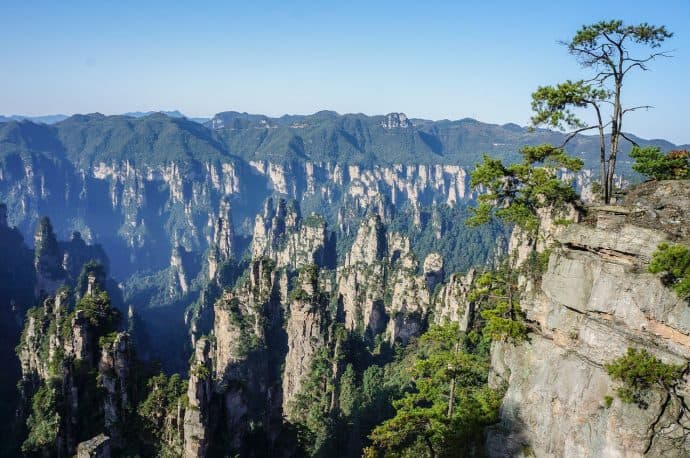
Zhangjiajie (China)
Located in the northwestern part of China’s Hunan province, the 11,900-acre Zhangjiajie National Forest Park is part of the larger Wulingyuan Scenic Area, a protected UNESCO World Heritage Site.
China’s first national forest park, Zhangjiajie is best known for its massive pillar-like geological formations. They’re commonly known as the Avatar Mountains, as they were the inspiration for the Hallelujah Mountains featured in James Cameron’s 2010 film, Avatar.
Though these massive pillars resemble limestone karst landscapes, they were actually formed by years of physical erosion resulting from expanding ice in wintertime. The tallest, which was formerly known as the Southern Sky Column, measures over 3,050 feet.
Due to the year-round moist weather, the foliage here is always abundant and verdant. If you visit, head to the Zhangjiajie Grand Canyon Glass Bridge, where you can take in jaw-dropping views from a scenic perch atop the mountain.
Plan to spend at least two to three days in the area, and make sure to bring good shoes for walking! The best times to visit are in summer (when the weather is best) or in autumn (if you want to avoid the crowds).
READ MORE: The Best Travel Clothes for Women & Men (An Epic Guide)
BEST MOUNTAINS IN EUROPE
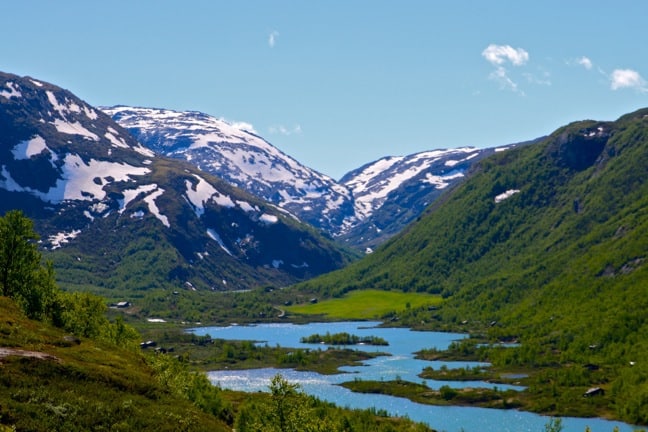
Jotunheimen Mountains (Norway)
Arguably our favorite part of an epic week-long Fjords of Norway road trip, the Jotunheimen Mountains are a highlight of the gorgeous Sognefjellet National Tourist Route.
Driving is the best way to see it, because the route takes you through Northern Europe’s highest mountain pass. There are so many jaw-dropping scenic vistas along the way, you’ll want to stop and take photos after nearly every stomach-turning switchback.
County Road 55 has connected eastern and western Norway for centuries, running from the quaint villages of the Sognefjord to the verdant Bøverdalen valley. Along the way, you’ll find yourself surrounded on all sides by snow-capped mountains, impossibly green fields and rushing waterfalls.
The views only get more stunning as you ascend into Jotunheimen (which aptly translates as “The Home of the Giants”). This 1,351-square mile area contains all of the 29 highest mountains in Norway, most of which tower over 6,600 feet.
Even at the beginning of Norway’s high tourist season, you’ll likely see very few other cars along the way. In fact, we saw more sheep than people– most of them allowed to graze freely.
READ MORE: Driving Through Norway’s Jotunheimen Mountains
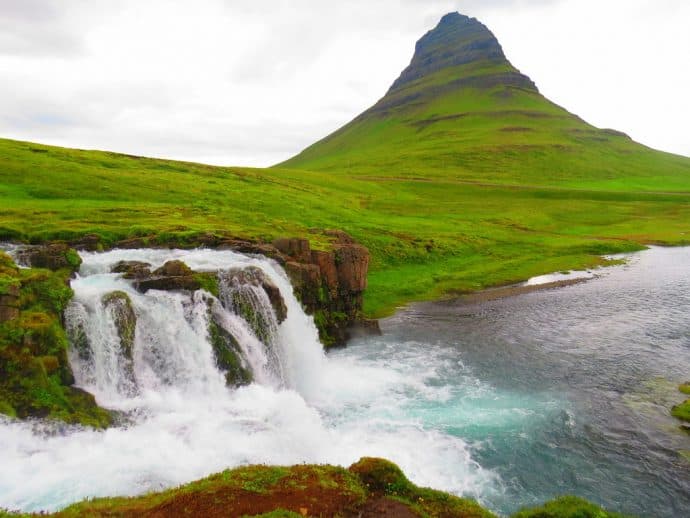
Kirkjufell (Iceland)
Located along the main road (Route 54) in Grundarfjordur, Iceland, Kirkjufell is considered one of the most photographed mountains in the world. Game of Thrones fans may recognize “church mountain” (named for its uncanny resemblance to a church’s steeple) from the show’s seasons 6 and 7.
The 1,519-foot tall freestanding mountain is undeniably impressive– lush and green in summer months and often covered with ice and snow in the winter.
But it’s almost always seen in the background of another Snæfellsnes peninsula show-stopper, Kirkjufellsfoss, which is widely considered among the most beautiful Iceland waterfalls.
The falls are relatively small but remarkably picturesque, allowing visitors to walk right up to the cascading water. And when you combine the crystal-clear waters with Kirkjufell’s uniquely shaped summit, the site is arguably among the country’s most photogenic sites.
READ MORE: The Top 10 Things to Do in Iceland (For Nature Lovers)
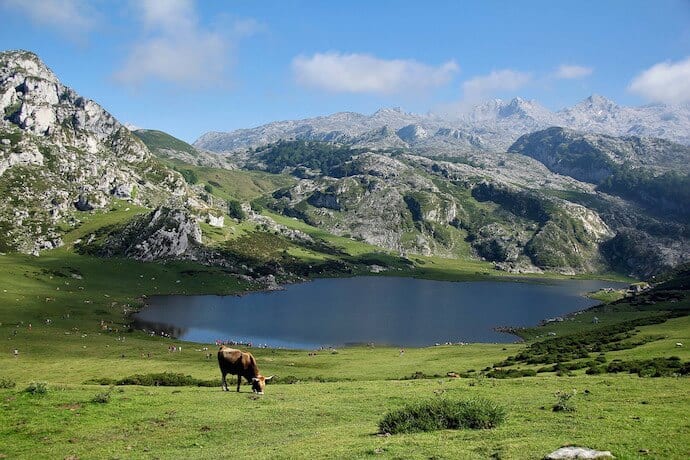
The Pyrenees (France/Spain)
One of Europe’s most picturesque mountain ranges, the Pyrenees divides the Iberian Peninsula from the rest of Europe. It stretches more than 260 miles across northern Spain and southern France, with numerous summits over 11,000 feet.
Some historians suggest the name came from Greek mythology, from a story about a princess who was raped by Hercules. After giving birth to a serpent, Pyrene runs into the woods and is torn apart by animals. The remorseful Hercules finds her body, and his wails of her name echo through the hills.
Today, these mountains are easily accessible from the major cities of Spain’s Catalonia region, including Barcelona and Girona. The gorgeous foothills, which climb over 8,000 feet and feature numerous waterfalls and hot springs, reach almost to the Mediterranean coast.
There are some hiking trails that traverse the entire length of the range, while four national parks (3 in Spain, one in France) offer shorter trails. The area is extremely popular in winter: Dozens of ski resorts can be found on both sides of the range.
Though not as rich with wildlife as other mountains on this list, the Pyrenees do boast some weird endemic animals. These include the shrew-like Pyrenean desman, the salamander-like Pyrenean euprocte, and the Pyrenean brown bear, which is slowly making a comeback after reintroduction.
READ MORE: Volunteering on a Vineyard in the Spanish Pyrenees
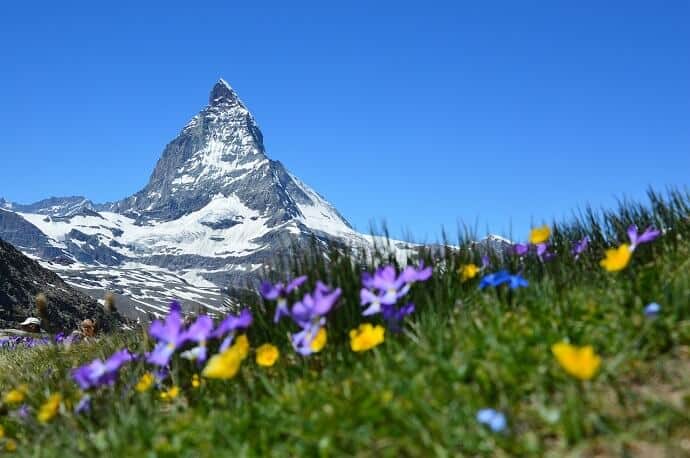
Swiss Alps (Switzerland)
As a recent rockslide attests, our awe of the Alps’ prettiness should never supersede our wariness of its potential peril.
For centuries, hikers have been under the spell of Dammastock’s dramatic peaks and Matterhorn’s majestic summit. Sadly, there have also historically been many tragic cases of adventurers not succeeding on their journeys.
The Matterhorn’s most distinctive feature is its well-defined pyramid shape, which has been incorporated into the Toblerone chocolate logo and a ride at Disneyland. At 14,620 feet, it’s easily the most photographed mountain in Switzerland, but only the 10th tallest.
For postcard-worthy views of the Matterhorn, take the cable car in Zermatt to reach the adjacent peak, Klein-Matterhorn (a.k.a. Little Matterhorn).
And of the course the slopes of the Alps are one of the most popular places for skiing and snowboarding in all of Europe.
READ MORE: Le Marche, Italy: A Local’s 7 Favorite Places to Visit
BEST MOUNTAINS IN OCEANIA
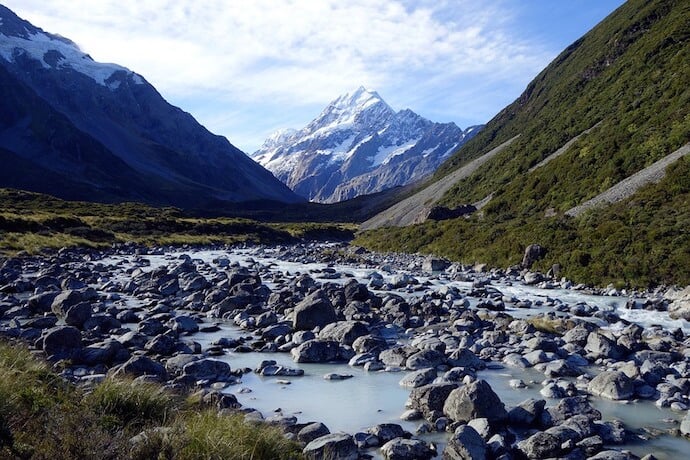
Aoraki/Mt. Cook (New Zealand)
Most people know New Zealand‘s most imposing mountain (12,316 feet) simply as Mount Cook.
But in a 1998 settlement between the area’s indigenous native people, the Ngai Tahu, and the Crown, the precious landmark was renamed Aoraki/Mount Cook.
Whatever the official title, everyone can agree that Aoraki’s majestic peaks are some of the most picturesque on the planet. And Aoraki/Mount Cook National Park is one of New Zealand’s most popular tourist attractions.
The mountain, whose three summits are always covered in snow, annually attracts thousands of climbing enthusiasts from all around the world.
But the park is also great for hikers who want to see its soaring glaciers (including Tasman Glacier, the longest in the country) and the gorgeous reflections provided by Lakes Pukaki and Tekapo.
READ MORE: Things to Do in Tongariro National Park (New Zealand)
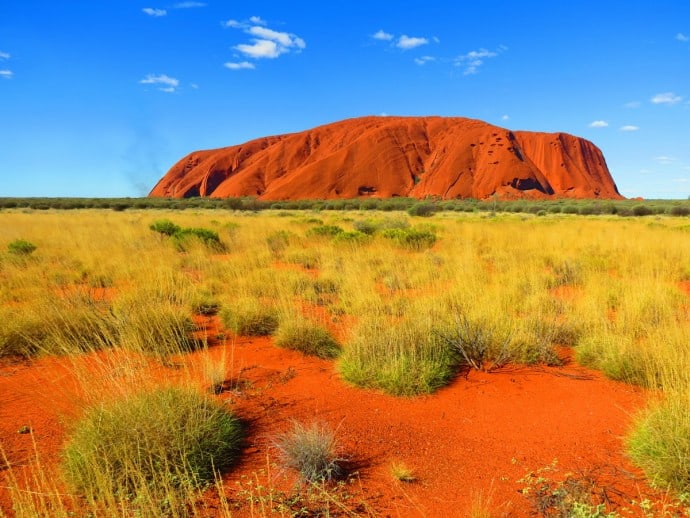
Uluru (Australia)
Of all the national parks in Australia, Uluru-Kata Tjuta National Park may be the most iconic due to Uluru, which rivals the Great Barrier Reef as the country’s most famous natural attraction.
Formerly known as Ayers Rock, this UNESCO World Heritage Site has been sacred to Australia’s indigenous Pitjantjatjara Anangu people for centuries. In modern times, it’s arguably the most internationally recognized symbol of the vast, rugged expanse known as the Outback.
Uluru rises nearly 1,150 feet above the desert. It’s best viewed at sunset or sunrise, when it turns a fiery red color. It takes roughly 3 hours to walk around the base of the mountain. Out of respect for the aboriginal people, responsible travel ideals suggest that tourists do not climb Uluru.
Despite the arid Northern Territory environment, the park is home to a surprisingly diverse array of plants and animals, including the adorable lizard known as the Thorny Devil.
Kata Tjuta is close by, and it’s easy to include if you’re taking an Australian road trip from Adelaide to Darwin. Kata Tjuta is also known as the Olgas, which have extensive spiritual and cultural significance for the local people.
READ MORE: The Top 10 Australian National Parks
BEST MOUNTAINS IN SOUTH AMERICA
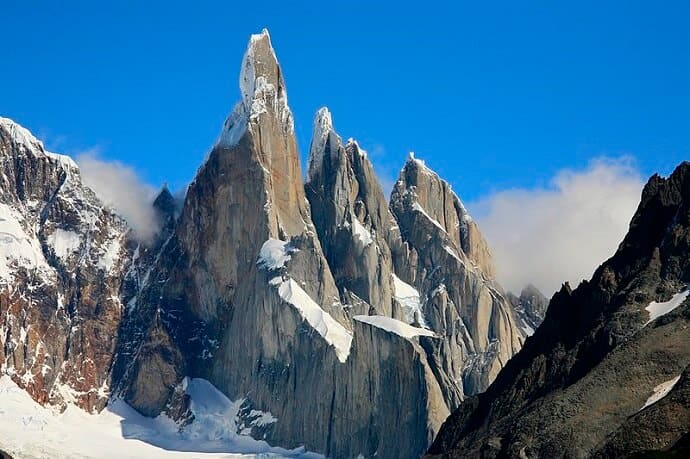
Cerro Torre (Argentina/Chile)
Cerro Torre rises up to over 10,000 feet through the southern reaches of the Patagonian Ice Field. It’s rocky finger of a mountain that suggests something out of Lemony Snicket, with a small bulb of ice at the top to boot.
Not only is the mountain a disputed territory between Argentina and Chile, but there’s a lot of disagreement regarding who first climbed it.
Italian climber Cesare Maestri claims to have scaled the mountain in 1959, with his partner (and only witness) Toni Egger dying in an avalanche. But later climbers found no evidence of the climb.
In 1970, Maestri attempted submitting Cerro Torre again. But this time he used a gas-powered air drill, which many climbers consider a desecration and believe totally disqualifies the ascent.
In early 2012, two different climbers (named Kennedy and Kruk) made the ascent, pulling out all of Maestri’s bolts, which stirred up a whole new controversy. The first undisputed ascent was made in 1974 by a team of Italian climbers known as “Ragni di Lecco.”
Regardless of the controversies, the mountain is considered incredibly difficult to climb. Even Jon Krakauer, author of Into Thin Air, made note of this. There’s also an adventure documentary, Cerro Torre– A Snowball’s Chance in Hell, about the “first ever free attempt” at climbing the mountain.
READ MORE: Top 20 Things to Do in Patagonia, South America
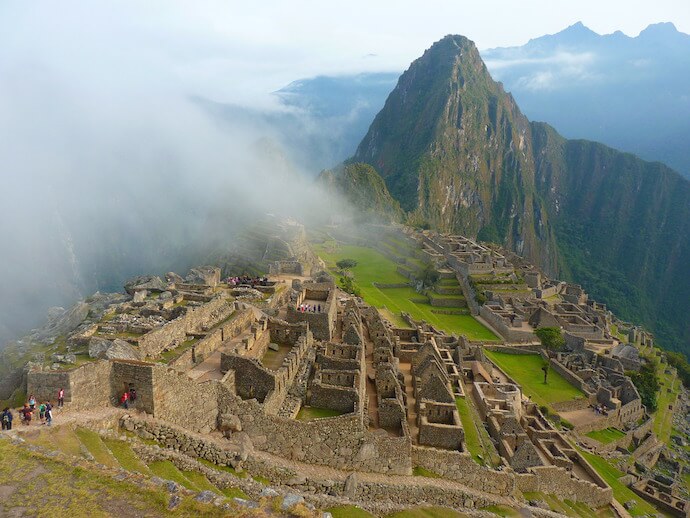
Huayna Picchu (Peru)
While rather diminutive in stature— a mere 8,835 feet— Huayna Picchu is a special mountain because of what you can see from it. Its hills provide picturesque views of the main square of Machu Picchu, which is widely considered one of the world’s greatest ancient archaeological sites.
The summit of Huayna Picchu, which is considered part of the 15th century Incan cultural site, is slightly higher than the celebrated Andean site and has its own ancient structures.
The trailhead to Huayna Picchu actually begins in Machu Picchu. The full trail is a loop that takes about 3.5 hours to complete. It includes both the amazing summit with the view, as well as a visit to the Moon Temple and Great Cavern, located near the base of the mountain.
Obviously, just reaching Machu Picchu, a treasured UNESCO World Heritage Site, can be a great adventure. Not only is it part of the New Seven Wonders of the World, but getting to it can include hiking the Inca Trail. If one goes that far, wouldn’t another few hours be worth it?
It’s an excellent opportunity to explore one of the great natural wonders of Peru.
READ MORE: 40 Best Backpacks for Travelers
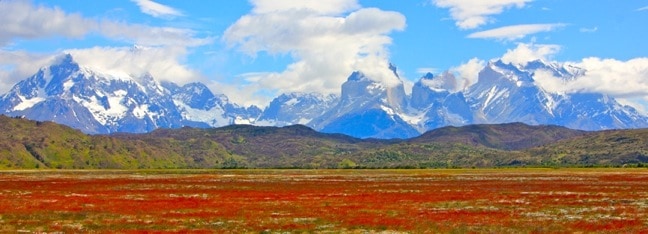
Torres del Paine (Chile)
Patagonia is home to some of the world’s most stunning scenic vistas, and Torres del Paine National Park is arguably the most jaw-dropping place in which to see them.
From towering rock formations (including the iconic Paine Massif) to expansive fields of wind-blown grasses that look like waves on a sea of green, Torres Del Paine’s landscapes are second to none. Perhaps this explains why National Geographic called the region, “Eden at the End of the World.”
The best hiking trail from which to see the photogenic summit is the famed W Circuit around Torres del Paine National Park. Ranging anywhere from 37 to 52 miles, depending on which route you choose, the world renowned trail usually takes about 4 days to complete.
The W Circuit’s finest sections include the hike through the Valle Francés (where you’re virtually surrounded by massive glaciers), and the approach to the Torres del Paine massif, whose dynamic rock towers give the national park its name.
Along the way you may see some of Patagonia’s Flora and Torres del Paine’s wildlife, which includes guanacos, foxes, caracaras, pumas, and the massive Andean condor.
READ MORE: Exploring Torres Del Paine National Park, Chile
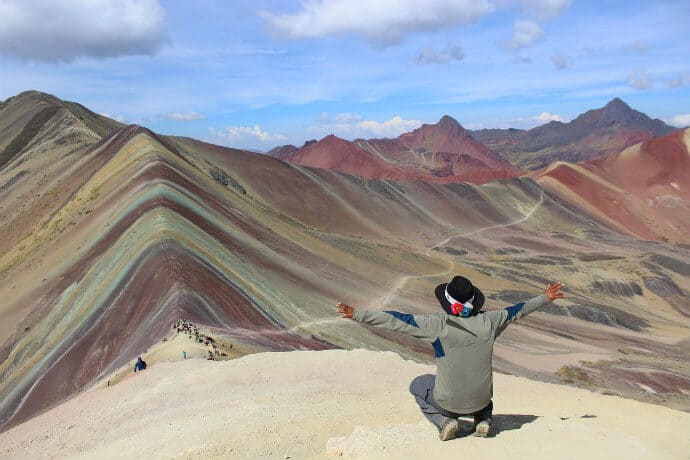
Vinicunca (Peru)
Also known as Montaña de Siete Colores, this 17,060-foot peak in the Peruvian Andes near Cusco is arguably the world’s most colorful mountain.
Known internationally as “Rainbow Mountain,” Vinicunca is part of the remote Ausangate range. Its unusual blue, green, red, and yellow striated hues were created by the area’s array of mineral deposits, including iron, sulfur, and copper.
Volcanic activity gradually pushed these layers up and sideways over the eons, with glaciers and weathering carving them into dynamic shapes.
These hills have been considered sacred since the pre-Inca era, and they’re still revered by the Quechua people who inhabit the area today. Many make annual pilgrimages to the mountain during the Snow Star Festival, which is held 60 days after Easter.
Though it’s considered a fairly difficult hike, the Ausangate Mountain trek offers adventurers a rare opportunity to explore one of Peru’s most beautiful natural attractions.
You probably won’t see many other hikers. But you will get a chance to see soaring Andean condors and other wildlife, soak in remote hot springs, and view the colorful sandstone mountains up close.
READ MORE: The World’s Most Colorful Beaches (for Your World Travel Bucket List)
BEST MOUNTAINS IN NORTH AMERICA
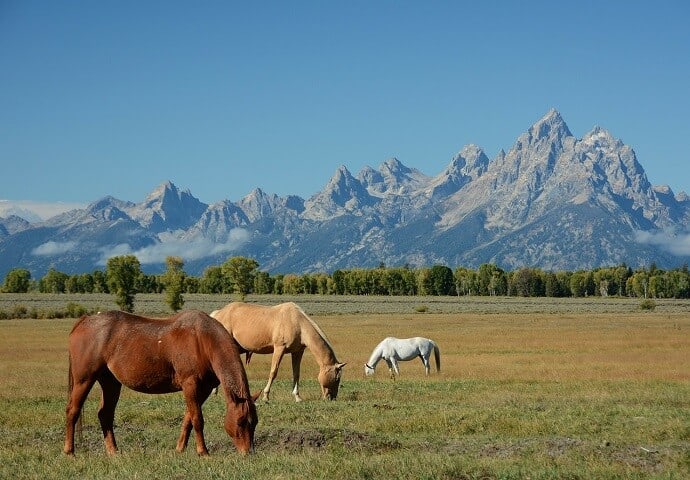
Grand Teton (United States)
Grand Teton is arguably one of North America’s finest national parks. It’s incredibly scenic and accessible, but not as overrun with mass tourism as, say, Yellowstone National Park.
Within the 480 square mile park’s boundaries, the 40-mile-long Teton Range rises from seemingly nowhere, with no foothills to provide a slow build up to the dramatic grandness.
Grand Teton, the park’s namesake mountain, is the range’s tallest peak at 13,775 feet. Amazingly, that only puts it as the second highest summit in Wyoming, with Gannet Peak (which is about 40 feet taller) taking the gold.
Nevertheless, in terms of breathtaking scenery and being awed by a mountain’s beauty, Grand Teton is pretty difficult to top. There are a few dozen different routes for climbing it, and at least five routes for skiing back down.
The area has plenty of camping, hiking, watersports, and historical cowboy culture to explore. It’s also one of the best national parks in the USA for watching wildlife. There are 60+ mammal species there, including grizzlies, wolves, elk, moose, river otters, cougars, and wolverines.
Though it doesn’t necessarily rank impressively in terms of North America’s highest peaks, the overall experience insists that Grand Teton be included on any list of America’s best mountains.
READ MORE: An Epic List of US National Parks By State
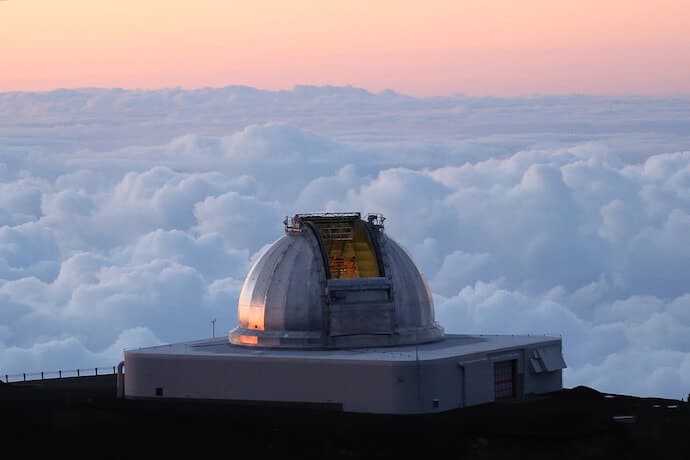
Mauna Kea (United States)
If you strictly measure from sea level to summit, Mount Everest is easily the tallest mountain on the planet at 29,029 feet.
But if you go from the top of the mountain to its base, Hawaii’s Mauna Kea is actually the biggest, measuring 33,476 feet from its base on the floor of the Pacific Ocean. The problem is that all but 13,796 feet of the dormant volcano’s massiveness lies hidden underwater.
Still, it’s a formidable landmark, and watching the sun set from above the clouds on its summit is one of our favorite things to do on the Big Island of Hawaii. The awe-inspiring 8-hour tour takes you up the mountain slowly, stopping at the visitor center to eat dinner and get acclimated to the altitude.
The view from the top is literally dizzying: You’re above 40% of Earth’s atmosphere, surrounded by the world’s leading astronomical observatories. It’s crazy to go from bikinis on the beach to parkas on the snow-capped summit in one day, but it’s one of the things that makes Hawaii so awesome.
Afterwards you descend to an area near the visitor center, where the crystal clear night sky makes for an exceptional stargazing experience. By the time you’re done, you’ll understand why this sacred place figures prominently in indigenous Hawaiian mythology.
READ MORE: Hawaiian Mythology (Hawaiian Gods, Goddesses, & Legends)
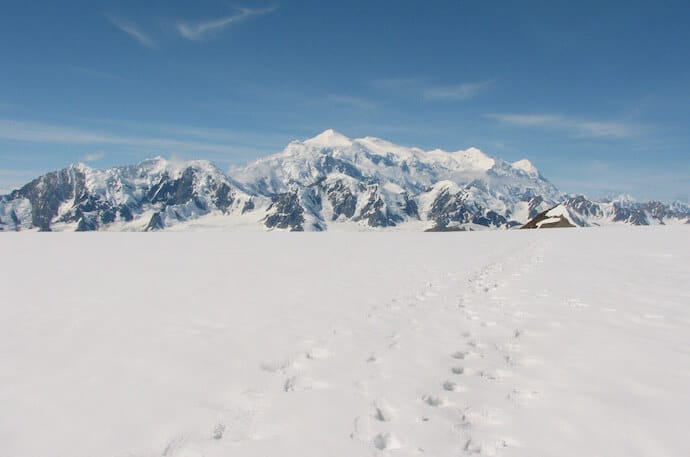
Mount Logan (Canada)
Located in Canada’s southwestern Yukon territory (just under 25 miles from the Alaska state line), Mount Logan is the tallest mountain in the country.
It’s also the second highest summit in North America, not to mention being recognized as having the largest base circumference of any mountain (volcanoes not included) on the planet.
Mount Logan is located in the 8,499 square mile Kluane National Park & Reserve, a vast wilderness of forests, glacier-fed rivers, ice fields, and dynamic landscapes. Wildlife in the park include caribou, moose, grizzly bears, Dall sheep, wolves, and more than 100 different species of birds.
Mount Logan is actually a massif, which is a mountain mass that– via faults and flexures– has moved up as a single unit. Thanks to tectonic action, the mountain is continually gaining height. Apparently, the sky isn’t actually the limit!
Mount Logan’s highest summit, Philippe Peak, has been calculated at 19,551 feet. It also has one other peak above 19,000 feet, the East Peak, as well as a half-dozen peaks over 18,000 feet and two over 17,000. In other words, there’s a lot of summiting to be had on this ridiculously rotund mountain. –by DeMarco Williams, Bret Love, and Jonathan Engels
READ MORE: 60+ Cool Camping Gear Reviews

